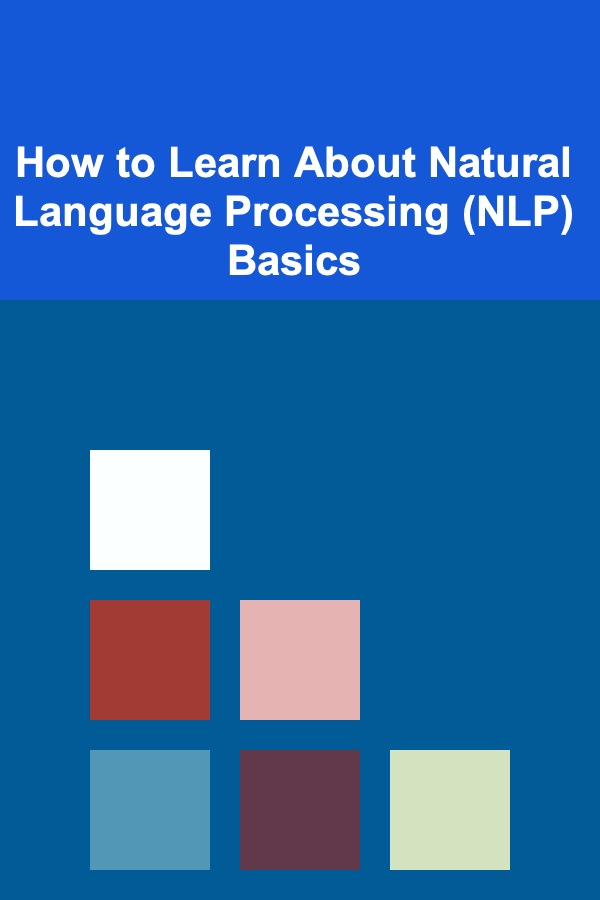
How to Learn About Natural Language Processing (NLP) Basics
ebook include PDF & Audio bundle (Micro Guide)
$12.99$6.99
Limited Time Offer! Order within the next:

Natural Language Processing (NLP) is a subfield of Artificial Intelligence (AI) that deals with the interaction between computers and human (natural) languages. The goal of NLP is to enable computers to understand, interpret, and generate human language in a way that is both meaningful and useful. Given the rapid advancements in AI and machine learning, learning about NLP has become essential for anyone interested in AI, data science, or linguistics. In this guide, we will explore how to start learning about NLP, covering the fundamental concepts, practical tools, and learning strategies that will help you dive into this fascinating field.
Understanding the Basics of Natural Language Processing
Before diving into more advanced topics, it's important to understand the fundamental concepts that form the backbone of NLP. NLP is essentially about transforming unstructured text (like sentences or documents) into a format that can be analyzed computationally. To do this, several core tasks are involved, which can be broken down into two main categories: Language Understanding and Language Generation.
Language Understanding
Language understanding refers to the process of interpreting the meaning behind words and phrases. Some essential tasks in language understanding include:
- Tokenization: This is the process of splitting text into smaller chunks, called tokens. Tokens can be words, characters, or subwords.
- Part-of-Speech Tagging (POS): This involves identifying the grammatical category of words in a sentence, such as noun, verb, or adjective.
- Named Entity Recognition (NER): Identifying and classifying named entities such as people's names, locations, organizations, dates, etc.
- Sentiment Analysis: Determining the emotional tone behind a body of text, such as whether a review is positive or negative.
- Dependency Parsing: Understanding the syntactic structure of a sentence, focusing on the relationships between words.
Language Generation
Language generation involves creating human-like text from a machine. Examples include:
- Text Generation: Creating new text based on a given prompt, which is a task commonly handled by models like GPT (Generative Pretrained Transformers).
- Machine Translation: Automatically translating text from one language to another (e.g., Google Translate).
- Summarization: Condensing a long piece of text into a shorter version, while retaining key information.
These fundamental tasks are the building blocks of more complex NLP systems, and understanding them is essential for anyone interested in diving deeper into the field.
Building a Strong Foundation in Prerequisite Knowledge
NLP is a multidisciplinary field, and before you can fully grasp the intricacies of NLP techniques, you need a solid understanding of several key areas of knowledge. Let's explore these foundational subjects.
2.1 Programming
A strong foundation in programming, especially in Python, is crucial when learning NLP. Python is the go-to language in the NLP world because of its simplicity and the abundance of libraries available for text processing, machine learning, and deep learning. Key Python libraries you'll need to be familiar with include:
- NLTK (Natural Language Toolkit): A comprehensive library for text processing tasks like tokenization, POS tagging, and NER.
- spaCy: A fast and efficient library designed for industrial-strength NLP tasks.
- TextBlob: A simple library built on NLTK for performing basic NLP tasks like sentiment analysis and translation.
- Transformers (Hugging Face): A library for working with transformer-based models like BERT, GPT, and T5.
If you're new to programming, it's advisable to start with basic Python tutorials and gradually move into libraries related to NLP.
2.2 Mathematics and Statistics
NLP relies heavily on mathematical concepts such as linear algebra, probability theory, and statistics. At a basic level, understanding these concepts will help you better comprehend the algorithms and models used in NLP. Key concepts include:
- Linear Algebra: Vectors and matrices are central to machine learning, especially in representing word embeddings.
- Probability and Statistics: Concepts like probability distributions, Bayes' theorem, and hypothesis testing are crucial for understanding models like Naive Bayes and Hidden Markov Models.
You don't need to be a mathematics expert, but a good understanding of these topics will make it much easier to grasp the underlying mechanics of NLP algorithms.
2.3 Linguistics
NLP is, at its core, the intersection of linguistics and computer science. Understanding basic linguistic concepts can significantly enhance your ability to design and develop NLP systems. Some useful linguistic concepts include:
- Syntax: The structure of sentences, including the rules governing word order and relationships between words.
- Semantics: The study of meaning in language, including how individual words and phrases relate to concepts and the world.
- Pragmatics: Understanding how context influences the interpretation of language.
- Morphology: The study of word structures and how words are formed from prefixes, suffixes, and roots.
You don't need to become an expert in linguistics, but familiarizing yourself with these terms and concepts can deepen your understanding of how language works.
Key NLP Techniques and Models
Once you have a solid foundation in programming, mathematics, and linguistics, it's time to start learning about the key techniques and models used in NLP. These can be broadly categorized into traditional approaches and modern deep learning approaches.
3.1 Traditional NLP Approaches
In the early days of NLP, techniques focused on rule-based methods and statistical models. Some of the traditional approaches include:
- Rule-based Systems: Systems that rely on a set of manually defined rules to process and understand language. These were some of the first techniques used in NLP, though they have largely been superseded by data-driven methods.
- Bag-of-Words (BoW): A statistical representation of text, where a document is represented as a collection of words and their frequencies. It ignores the order and structure of words.
- TF-IDF (Term Frequency-Inverse Document Frequency): A statistical method used to assess the importance of words in a document relative to a corpus.
- Hidden Markov Models (HMMs): Used for sequence prediction tasks, such as speech recognition and POS tagging, HMMs model sequences of observations with an underlying hidden state.
While traditional approaches are still useful for certain tasks, modern NLP has largely shifted towards deep learning methods.
3.2 Deep Learning for NLP
In recent years, deep learning techniques have revolutionized NLP by enabling models to learn directly from large datasets without the need for manually defined features or rules. Some of the most significant models include:
- Word Embeddings: Techniques like Word2Vec, GloVe, and FastText represent words as dense vectors in a continuous space, capturing semantic relationships between words.
- Recurrent Neural Networks (RNNs): RNNs are designed to handle sequential data, such as sentences or time series, and are used for tasks like language modeling, machine translation, and speech recognition.
- Long Short-Term Memory (LSTM): A type of RNN that is capable of learning long-range dependencies, addressing the vanishing gradient problem in traditional RNNs.
- Transformers: A deep learning architecture that has become the foundation for state-of-the-art NLP models. Models like BERT, GPT, and T5 use transformers to process text in parallel, allowing them to handle long-range dependencies more effectively than RNNs.
Transformer-based models, in particular, have set new benchmarks for performance on many NLP tasks, and understanding them is crucial for anyone looking to dive deeper into the field.
Learning Resources and Platforms
Learning NLP can be a complex but rewarding endeavor. Fortunately, there are numerous online resources available to help you at every stage of your learning journey. Below are some excellent platforms and resources to consider:
4.1 Online Courses
- Coursera: Offers a variety of NLP courses, including the popular "Natural Language Processing Specialization" by the National Research University Higher School of Economics.
- edX: Platforms like edX also provide NLP-related courses from institutions like Stanford and MIT.
- Udacity: Known for its Nanodegree programs, Udacity offers in-depth courses on NLP and AI.
4.2 Textbooks
- "Speech and Language Processing" by Daniel Jurafsky and James H. Martin: This is one of the most widely used textbooks in NLP and provides a comprehensive introduction to both theoretical and practical aspects of the field.
- "Natural Language Processing with Python" by Steven Bird, Ewan Klein, and Edward Loper: This book is a great hands-on resource for learning how to use Python for NLP tasks.
4.3 Research Papers and Journals
- arXiv.org: A repository of research papers, many of which focus on cutting-edge NLP techniques.
- Google Scholar: Use Google Scholar to search for academic papers and stay up-to-date with the latest developments in the field.
4.4 Tutorials and Blogs
- Hugging Face Blog: Hugging Face provides tutorials on how to use transformer models for various NLP tasks.
- Towards Data Science: A popular Medium publication that frequently posts articles and tutorials on machine learning and NLP.
4.5 Communities and Forums
- Stack Overflow: A great place to ask specific questions related to programming and NLP.
- Reddit (r/MachineLearning, r/NLP): Reddit has active communities discussing the latest trends and research in NLP.
- GitHub: Explore open-source projects and repositories to see how other developers are approaching NLP tasks.
Practical Tips for Learning NLP
Here are some practical tips to help you along the way:
- Practice, practice, practice: NLP is a hands-on field. Try to implement what you learn by working on real-world projects, such as text classification, sentiment analysis, or machine translation.
- Start with small projects: Build simple applications like a chatbot or a text classifier before moving on to more complex projects.
- Join a study group: Collaborating with others can make the learning process more enjoyable and productive. Look for online communities, meetups, or coding groups focused on NLP.
- Experiment with pre-trained models: Modern NLP tools like Hugging Face's Transformers library provide access to powerful pre-trained models. Experimenting with these models can help you understand how they work and give you a sense of what's possible with NLP.
Conclusion
Learning about Natural Language Processing is an exciting and challenging journey that combines programming, linguistics, and machine learning. By understanding the basics of language understanding and generation, building a strong foundation in prerequisite knowledge, mastering key techniques, and leveraging various learning resources, you can build your expertise in this dynamic field. With continued practice and dedication, you'll be well on your way to becoming proficient in NLP, contributing to the ongoing revolution in AI and its applications to language.

How to Create a Cozy and Inviting Living Room Renovation
Read More
How to Create an Indoor Exercise Routine for Your Pet
Read More
How to Leverage Seasonal Demand for Higher Rent
Read More
How to Make Use of Lofted Spaces for Storage
Read More
How to Throw an Elegant Dinner Party at Home on a Budget
Read More
How to Use a Credit Card Responsibly
Read MoreOther Products

How to Create a Cozy and Inviting Living Room Renovation
Read More
How to Create an Indoor Exercise Routine for Your Pet
Read More
How to Leverage Seasonal Demand for Higher Rent
Read More
How to Make Use of Lofted Spaces for Storage
Read More
How to Throw an Elegant Dinner Party at Home on a Budget
Read More